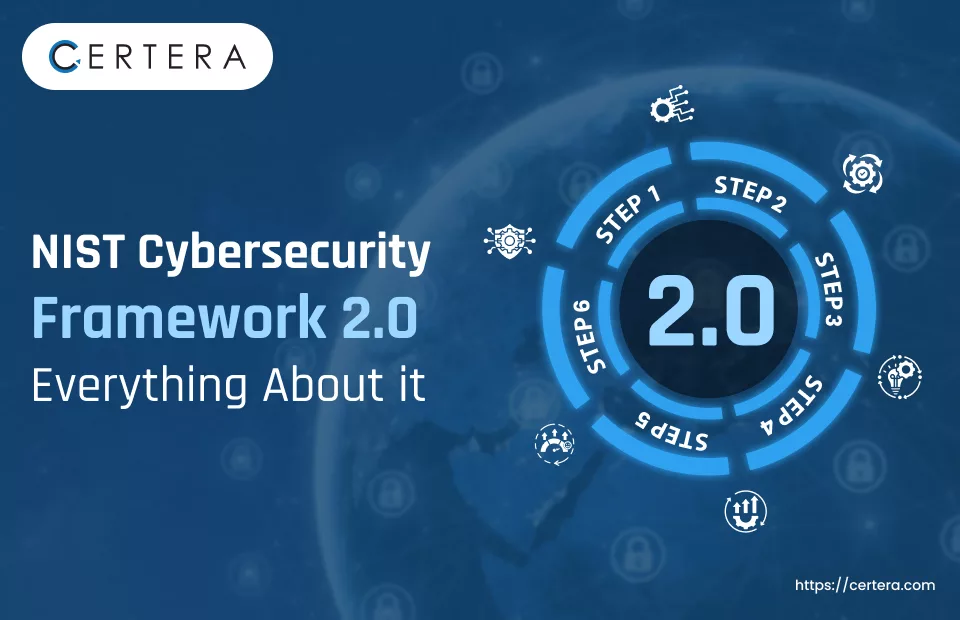NIST Cybersecurity Framework 2.0: The Gold Standard for Proactive Cyber Defense

Introduction
In the cyber world, where cyber threats are progressing ahead of speed, cybersecurity has become so crucial, and almost everybody thinks that cybersecurity factors are their most urgent need.
Meanwhile, the National Institute of Standards and Technology (NIST), disregarding the responsibility, provided a resolution to this concern by designing the Cybersecurity Framework 2.0, the more recent version of its widely applied framework for managing cybersecurity risk.
What is the NIST Cybersecurity Framework?
Though the NIST Cybersecurity Framework is a voluntary set of standards and suggested practices to help firms strengthen their cybersecurity, organizations are widely adopting it. It provides a flexible and scalable platform that covers all areas of cyber security, thus making it possible to manage cyber risk in all sectors and organizations of all sizes.
Key Updates in Cybersecurity Framework 2.0
Cybersecurity Framework 2.0, the success of its predecessor, has served as a basis, including user and industry support on new cybersecurity threats and technologies which include:
Increased Focus on Supply Chain Risk Management:
Supply chain attacks are an inherent problem for most organizations. This new framework now focuses on the critical issues of third-party risk management, including the need for all parties involving third-party vendors, suppliers, and partners to have the right management standards.
Integration of Privacy Risk Management:
The Privacy Programs combine provisions, procedures, and information exchanges. With the increasing popularity of data security regulations, the Cybersecurity Framework 2.0 addresses privacy risks and integrates privacy practices, similar to the NIST Privacy Framework.
Emphasis on Software Supply Chain Security:
As we are more connected to software and face challenges from uncovered vulnerabilities and infringed software, the framework has been instrumental in guiding the protection of the software supply chain.
Alignment with International Standards:
The new version of the Cybersecurity Framework has been designed in a way to enable international interoperability as it is compliant with different international standards and frameworks, including the ISO/IEC 27001 and NIST Risk Management Framework.
Benefits of Adopting the NIST Cybersecurity Framework 2.0
Improved Cyber Resilience:
Through the systematic implementation of the framework’s reasonable precautions, companies can significantly increase their power of forecasting, preparedness, resilience, and, ultimately, their business sustainability and financial recoveries.
Facilitated Compliance:
The framework provides a systematic way of meeting the regulations and opinions relevant to industries. Hence, it removes the difficulty from the innumerable compliance processes and lowers the risk of avoiding penalties due to non-compliance.
Increased Stakeholder Confidence:
Organizations’ commitment to cybersecurity operations becomes evident with the application of the NIST cybersecurity framework 2.0, which, in turn, adds a layer of trust among customers, partners, and stakeholders.
Cost Savings:
By being proactive, it is possible to successfully avert cyber risks and reduce the costs associated with data breaches, system failures, and incident response.
Getting Started with the NIST Cybersecurity Framework 2.0
Understand Your Organization’s Cybersecurity Needs:
Evaluate your organization to establish its particular needs, the degree of risk of exposure, as well as your stakeholder’s viewpoint for the framework to include the implementation plan.
Establish a Cybersecurity Program:
Develop a comprehensive cybersecurity program aligned with the framework’s core functions: Establish, Observe, Identify, Protect, Detect, Respond, and Recover.
Engage Stakeholders:
Involve all relevant stakeholders, e.g., chief executives, IT, and business units, to ensure a positive company response and implementation.
Continuously Monitor and Improve:
Conduct audits of your cybersecurity implementation to make it resilient to the moving threats, new technologies, and occurrences that shape your risk profile.
Conclusion
Being punitive in today’s cyber threat environment can no longer be seen as a lasting solution. The impacts of inaction are unbearable, ranging from crippling operations to massive data losses.
At the same time, the trust of customers and brand reputation takes an untold hit. The latest version of the NIST Cybersecurity Framework serves as a strong reference for agencies in their preparation to counter current and future cyber threats and build defenses preventatively.
Implement a globally recognized standard in order to uplift the level of analysis that you conduct in vulnerability discoveries, risk reduction, and quick response to incidents.
Gain an ultimate edge today, being one of the most elite cybersecurity forces with Certera.
Frequently Asked Questions
Is the NIST Cybersecurity Framework 2.0 mandatory for all organizations?
The NIST Cybersecurity Framework is a voluntary, effective set of guidelines and best practices, in contrast to the mandatory standards and regulations. Nevertheless, incorporating this method attracts the best public nod because it presents a powerful mechanism to mitigate cybersecurity risks.
Can the framework be applied to organizations of any size or industry?
Yes, NIST Cybersecurity Framework version 2.0 is meant to be both flexible and scalable. It is meant to be applicable to organizations of all sizes and to those in sectors like healthcare, finance, manufacturing, and others.
How does the Cybersecurity Framework 2.0 differ from other cybersecurity standards or frameworks?
Unlike other frameworks, the NIST Cybersecurity Framework 2.0 is conscious of its scope in ensuring the detection of risks from start to finish and to help respond effectively to incidents as part of the whole lifecycle.
In addition to that, it provides the world with a common set of phrases, as well as a term sovereignty for cybersecurity, which allows for more effective communication between the roles.
Can the framework be integrated with existing cybersecurity programs and controls?
Absolutely. The NIST Cybersecurity Framework 2.0 is designed to fit with an organization’s cybermatics defense measures, thereby ushering in a stress-free migration.
How often should organizations review and update their cybersecurity program based on the framework?
It is advised to conduct periodic reviews and revisions of the cybersecurity program to ensure that it meets all prescriptions of the framework in terms of following the guidelines and efficiently manages risks related to cyber-attacks and changes that can be introduced by changing risk profiles.
One well-established practice is supporting reviews, which may come at a different pace depending on your circumstances and needs.
